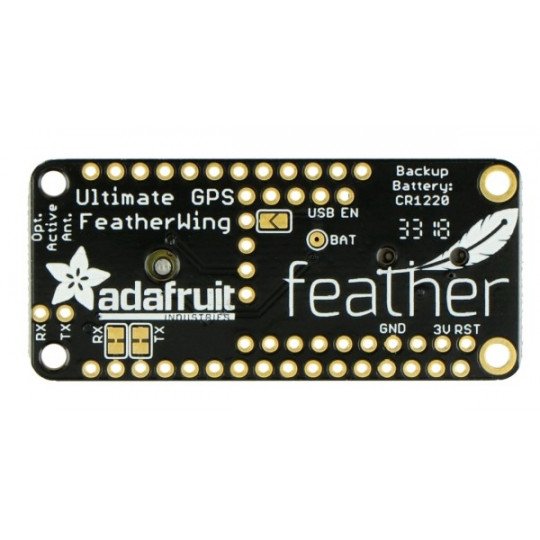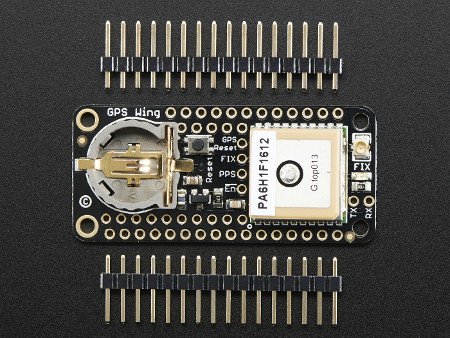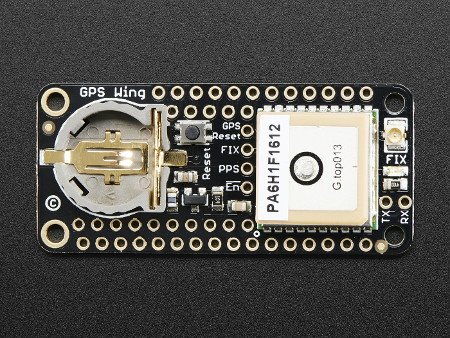Description
Board from theFeatherfamily with the MTK3339 GPS module that can track up to 22 satellites for 66 channels. The system has a built-in antenna, the receiver's sensitivity - 165 dB. It is powered with voltage from 3 V to 5.5 V, consuming only 20 mA of current during navigation. The frequency of the update is 10 Hz which means the new data 10 times per second.
Low energy consumption
Through the use of the ENABLE pin, the module can be disabled from the GPIO pin of any microcontroller. Connector of the batteryCR1220, so-called small pill (not included), gives the possibility of maintaining the RTC opertaion in the absence of main power.
Monitoring of the stae
The LED indicator allows to monitor the status of the GPS module. Blinking with a frequency of about 1 Hz means looking for the satellites, the appearance of light every 15 seconds indicates finding FIX. The LED signal is displayed on the FIX goldpin connector so you can read it via the microcontroller.
Range
Built-in ceramic antenna yields a sensitivity of 165 dB, for increasing this parameter you can attach an external version via the connector u.FL. Since most of the available antennas have SMA connector, in our offer, you will find a suitable adapter u.FL - SMA.
Data registration
The MTK3339 module has a built-in Flash memory, which allows recording of measured data. You need to send a proper command from microncontroller and the collected data (time, date, latitude and longitude) will be stored in memory. At that time, the microcontroller goes into sleep mode and is woken up only to read the collected information. Internal memory allows to record up to 16 hours of data.
The kit includes:PCB, connectors, for self-soldering.
|
The product is compatible with Arduino The manufacturer providesthe Arduino libraryalong withthe user manual. |
Basic module features:
- Supply voltage: from 3.0 V to 5.5 V
- Current consumption: 25 mA, when searching the satellite, 20 mA during navigation
- Communication: NMEA 0183, 9600 b/s
- Positioning accuracy: up to 3 m
- Maximum speed: 515 m/sec
- Sensitivity: -165 dBm
- Update: 10 Hz
- Low current consumption: about 20 mA
- The ability to track up to 22 satellites
- Built-in Flash memory to save data
- Warm/cold start: 34 seconds
- The LED indicators of the status of the FIX
- Support for DGPS/WAAS/EGNOS
- It has a built-in antenna and a connector to lead the external u.FL version out
- Built-in RTC provides a record of the actual time
- Provided free libraries facilitate the handling of a shield
- Dimensions: 22,9 x 51,2 x 6.7 mm
- Weight: 8.8 g (without battery)
Leads
| Pin | Description |
|---|---|
| 3B | Supply voltage from 3.0 V to 5.5 V. |
| GND | The weight of the system |
| TX, RX | Connectors of the serial interface GPS NMEA 0183, 9600 bps. |
| FIX | The output indicates the device status - it is the same as that connected to status LED. |
| BAT | Lead connected to the extra power of a real time clock, connected to the battery connector. The maximum voltage that can be applied to this pin is 3.3 V. |
| EN | Pin allows you to turn off the module using any GPIO of the microcontroller. By default, it is pulled up to VIN through 10 kΩ, providing the low statusshuts down the system. |
| 3.3 V | Regulator output is 3.3 V with a maximum performance of 100 mA. |
| PPS | The output of the pulse-per-second signal of the GPS module. |
| Reset | A restart of the module. Not connected to the GPS without connecting the jumper to the other side. |




















































































































































































































































































































































